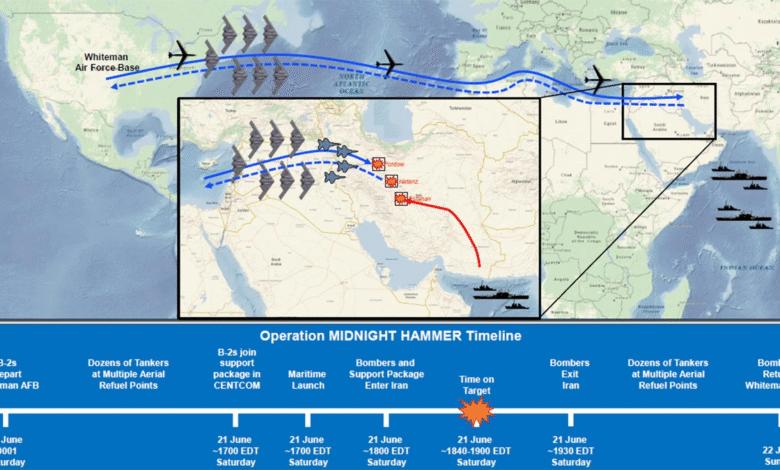Operation Midnight Hammer: U.S. Claims Iran Nuclear Sites Obliterated

In a bold military maneuver, “Operation Midnight Hammer” aimed to dismantle Iran’s nuclear infrastructure, yet the impact of the U.S. missile attack on key facilities like Fordo, Natanz, and Isfahan has sparked significant debate. Intelligence reports suggest that instead of obliterating Iran’s nuclear capabilities, the operation may have merely delayed their progress by a few months. While U.S. Defense Secretary Pete Hegseth confidently declared the bombing a success, refuting any claims of limited effectiveness, assessments from various intelligence sources indicate otherwise. The operation, which utilized advanced bunker buster bombs, is shrouded in skepticism, raising questions about the Trump administration’s narrative. As the geopolitical landscape evolves, understanding the true consequences of Operation Midnight Hammer becomes increasingly critical, particularly concerning the stability of U.S.-Iran relations.
In the context of ongoing tensions in the Middle East, the recent airstrikes on Iranian nuclear sites have been classified as a part of a larger strategy known as “Operation Midnight Hammer.” This initiative involved precision strikes aimed at crippling Iran’s nuclear ambitions, specifically targeting underground facilities designed to withstand military assaults. Critics of the operation highlight discrepancies in the U.S. government’s assertions regarding the effectiveness of the attacks, calling into question the robustness of U.S. intelligence assessments. The use of sophisticated munitions, such as GBU-57 Massive Ordnance Penetrators, was intended to deliver a decisive blow to Iran’s capabilities. However, as various intelligence reports surface, the narrative surrounding the impact of these strikes continues to develop, revealing a complex interplay of military strategy and diplomatic implications.
The Impact of Operation Midnight Hammer on Iran’s Nuclear Program
Operation Midnight Hammer aimed to dismantle Iran’s nuclear capabilities through precise airstrikes on key facilities including Fordo, Natanz, and Isfahan. However, recent intelligence reports suggest that the impact may not be as monumental as initially projected. Despite the use of B-2 stealth bombers and bunker buster bombs designed to penetrate the most fortified of structures, it appears that the operation may have only temporarily deferred Iran’s nuclear ambitions rather than obliterating them entirely.
U.S. officials, under the Trump administration, initially touted the success of the bombings; however, the latest assessments indicate that Iran’s nuclear program could be pivoting back into functionality sooner than expected. While Defense Secretary Pete Hegseth claimed that the bombing campaign obliterated Iran’s capacity for creating nuclear weapons, the intelligence community holds a different narrative, suggesting that Iran remains operational amidst the rubble of its nuclear sites.
Frequently Asked Questions
What was Operation Midnight Hammer and what were its objectives?
Operation Midnight Hammer was a U.S. missile attack targeting key Iranian nuclear sites, specifically Fordo, Natanz, and Isfahan. Launched during the Trump administration, the operation aimed to cripple Iran’s ability to develop nuclear weapons by utilizing advanced bunker buster bombs and Tomahawk missiles.
Did Operation Midnight Hammer successfully destroy Iran’s nuclear sites?
Reports indicate that Operation Midnight Hammer did not completely destroy Iran’s nuclear sites. Intelligence sources suggest that while the attack may have delayed Iran’s nuclear advancements, it did not obliterate their capabilities, as initially claimed by U.S. officials.
What types of munitions were used in Operation Midnight Hammer?
Operation Midnight Hammer employed 14 GBU-57 Massive Ordnance Penetrators (MOPs), designed for penetrating heavily fortified underground targets, and over two dozen Tomahawk missiles. These advanced bunker buster bombs were crucial in targeting Iran’s nuclear facilities.
How did the Trump administration react to the reports on Operation Midnight Hammer’s effectiveness?
The Trump administration, particularly U.S. Defense Secretary Pete Hegseth, insisted that Operation Midnight Hammer successfully obliterated Iran’s capacity to create nuclear weapons. They dismissed contrary intelligence reports suggesting limited damage, calling such claims attempts to undermine the mission.
What is the significance of intelligence reports concerning Operation Midnight Hammer?
Intelligence reports regarding Operation Midnight Hammer have raised doubts about the attack’s effectiveness, suggesting that Iran’s nuclear sites remain operational. These conflicting assessments highlight the uncertainty surrounding U.S. military actions and their true impact on Iran’s nuclear capabilities.
What are the implications of the ongoing disputes about Operation Midnight Hammer?
The disputes surrounding Operation Midnight Hammer could affect U.S. foreign relations, particularly regarding Israel and Iran. As the assessment of damage remains contested, it complicates diplomatic efforts and underscores the precarious balance of power in the region.
| Key Point | Details |
|---|---|
| Operation Midnight Hammer | A U.S. missile strike on Iranian nuclear sites. |
| Targets | Fordo, Natanz, and Isfahan were the main nuclear facilities targeted. |
| Effectiveness of the Strike | U.S. claims of destruction are contested; damage might only delay nuclear advancements by months. |
| U.S. Government Reaction | Defense Secretary Pete Hegseth claims the bombing was successful and complete. |
| Intelligence Reports | CNN reports suggest less damage than claimed; underground sites may remain operational. |
| Military Tactics | Involved B-2 stealth bombers and Tomahawk missiles for maximum impact. |
| Public and Official Skepticism | Despite official support, doubts exist about the overall effectiveness of the operation. |
Summary
Operation Midnight Hammer represents a significant military initiative targeting Iran’s nuclear facilities; however, contrasting reports suggest that the intended obliteration may not have been fully realized. While U.S. officials assert the success of the strike, independent analyses raise concerns about the actual effectiveness, positioning Operation Midnight Hammer at the center of ongoing geopolitical tensions and debates.




